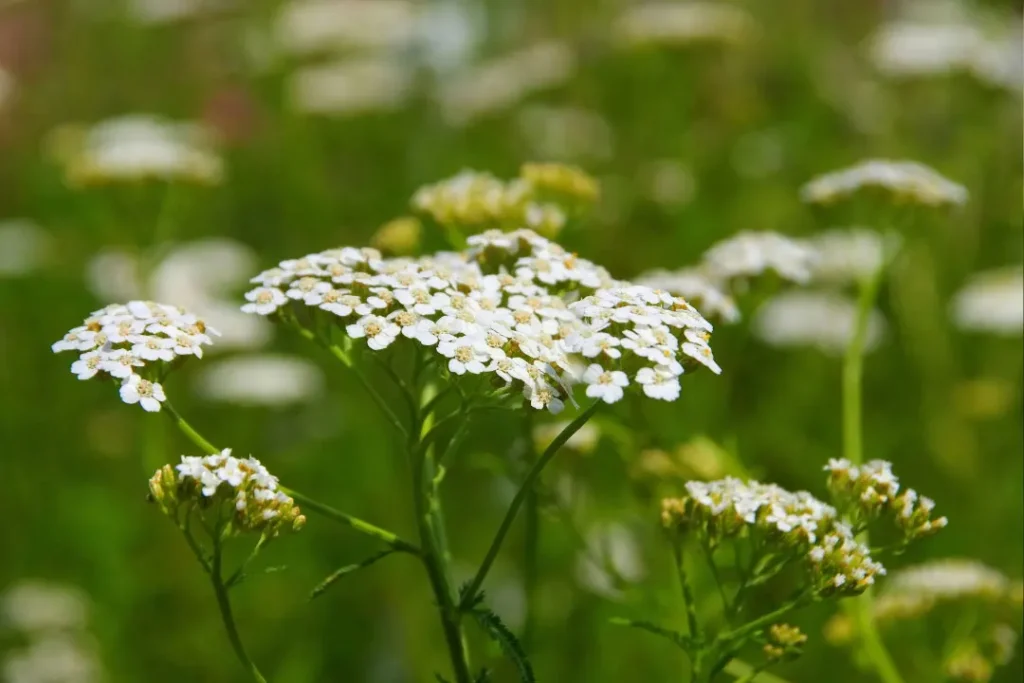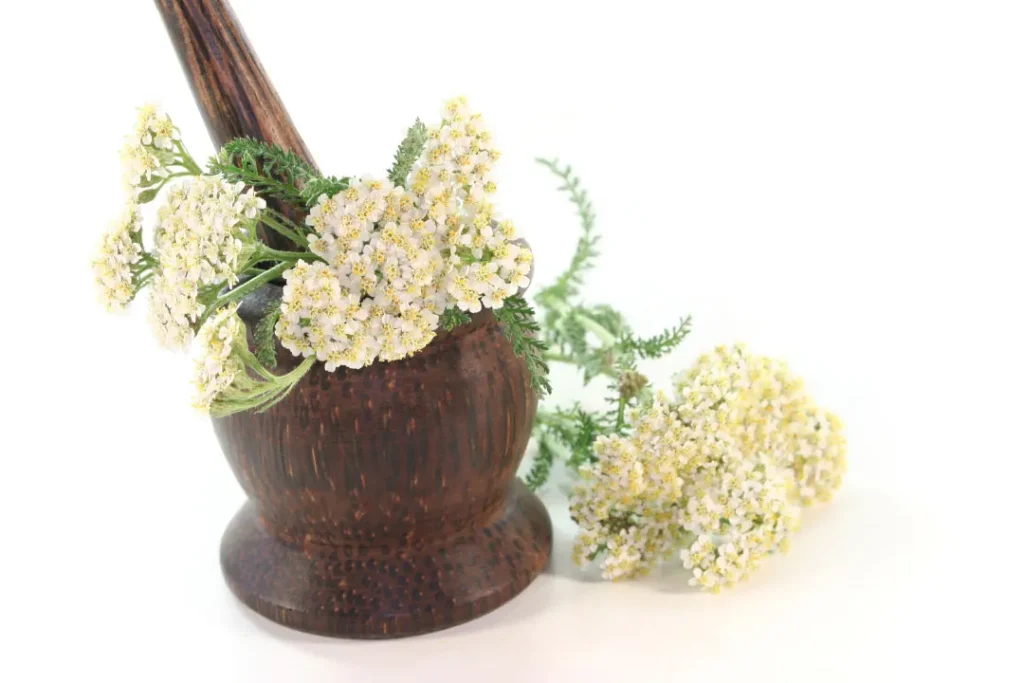Yarrow (Achillea millefolium) is a beautiful and hardy perennial herb that is found all over the Northern Hemisphere, bringing joy and beauty to many. Yarrow’s diverse therapeutic properties have been used for centuries in traditional medicine systems. This paper offers a thorough examination of the chemistry of yarrow, highlighting its numerous health benefits, recommended dosage, and responsible use as a nutritional supplement. It also discusses yarrow’s potential substance interactions and any possible side effects.
You May Also Like:
Green tea offers powerful health benefits
Stuffed With Health Benefits, Mushrooms Have Gone Mainstream
Nature of Yarrow
Yarrow (Achillea millefolium) is a beautiful and resilient perennial herbaceous plant that belongs to the Asteraceae family. This species has a wide distribution throughout the Northern Hemisphere, especially in temperate regions. Yarrow has beautiful, delicate, fern-like leaves and lovely clusters of small, charming white or light-pink flowers. It’s amazing to see how the plant has been used in traditional medicine systems across various cultures for its diverse therapeutic properties.

Health Benefits of Yarrow
The reported health benefits of yarrow are primarily attributed to its high concentration of bioactive compounds. Several health benefits have been extensively documented, including:
- Yarrow has been historically utilized for its anti-inflammatory and analgesic characteristics. It is postulated that the impact of sesquiterpene lactones present in yarrow is achieved through the inhibition of pro-inflammatory cytokine production and the modulation of critical inflammatory signaling pathways, including nuclear factor-kappa B (NF-κB) and mitogen-activated protein kinase (MAPK). Moreover, the anti-inflammatory properties of yarrow are attributed to the presence of flavonoids, which exhibit antioxidant activity.
- Yarrow has been utilized for an extended period to manage wounds, burns, and ulcers owing to its hemostatic and wound-healing characteristics. Studies have demonstrated that the sesquiterpene lactones and flavonoids present in yarrow possess wound-healing properties by stimulating the proliferation of fibroblasts, enhancing collagen synthesis, and modulating the inflammatory response. Moreover, the astringent characteristics of yarrow aid in the constriction of blood vessels, thereby diminishing bleeding and encouraging the formation of clots.
- Yarrow has been found to possess antimicrobial and antiviral properties attributed to the existence of sesquiterpene lactones and volatile oils, including camphor and cineole. The aforementioned compounds have demonstrated the ability to impede the proliferation of diverse types of microorganisms, such as Staphylococcus aureus, Escherichia coli, and Herpes simplex virus.
- Yarrow has been historically utilized to manage diverse gastrointestinal ailments including stomach cramps, diarrhea, and indigestion. It is postulated that yarrow’s flavonoids and sesquiterpene lactones bring an impact on the regulation of gastric acid secretion, facilitation of gastrointestinal motility, and mitigation of inflammation in the digestive tract.
Boost Your Mind and Body with the Best Yarrow Supplements—Discover Here!

Chemistry of Yarrow
Yarrow contains a wide range of bioactive constituents, comprising flavonoids, sesquiterpene lactones, alkaloids, volatile oils, and phenolic acids. The therapeutic properties of yarrow are attributed to its primary bioactive constituents, namely flavonoids and sesquiterpene lactones.
- Flavonoids are a type of secondary metabolite found in plants that exhibit antioxidant, anti-inflammatory, and anticancer characteristics. Yarrow is known to contain significant amounts of apigenin, luteolin, and their respective glycosides, which are classified as the primary flavonoids present in this plant. Flavonoids exhibit antioxidant properties through the process of scavenging free radicals and mitigating oxidative stress, thereby fostering cellular well-being and averting the onset of illnesses.
- Sesquiterpene lactones are a group of organic compounds that possess a 15-carbon skeleton and a lactone ring. Yarrow comprises various sesquiterpene lactones, including achillin, millefin, and artabsin. These compounds display a diverse array of biological functions, encompassing anti-inflammatory, antimicrobial, and anticancer attributes.

Physiological Mechanism of Action of Yarrow
The multifaceted health advantages of yarrow can be ascribed to its intricate assortment of bioactive constituents, which elicit diverse physiological impacts on the human body and mind. Several key mechanisms of action have been identified as primary.
- The anti-inflammatory and analgesic properties of yarrow are attributed to the presence of sesquiterpene lactones and flavonoids which helps the NF-κB and MAPK pathways. These compounds have the potential to decrease the perception of pain through their interaction with opioid receptors. They also hinder the discharge of pain-provoking agents such as bradykinin.
- As mentioned, sesquiterpene lactones and flavonoids exhibit wound-healing and hemostatic properties. Wound healing is promoted by regulating the inflammatory response and enhancing collagen production while hemostatic effects are due to the constriction of blood vessels. Yarrow’s antimicrobial and antiviral properties are mainly attributed to its sesquiterpene lactones and volatile oils, such as camphor and cineole. Both of them have demonstrated the ability to impede the proliferation of diverse microorganisms, including bacteria, fungi, and viruses, through the disruption of their cellular membranes, the inhibition of cell wall synthesis, or the obstruction of crucial metabolic pathways.
- As mentioned, flavonoids and sesquiterpene lactones modulate gastric acid secretion, promote gastrointestinal motility, and mitigate inflammation in the digestive tract. They safeguard the gastrointestinal mucosa against harm by augmenting the generation of mucus and impeding the excretion of detrimental substances such as histamine and leukotrienes.

Optimal Dosage of Yarrow
The determination of the appropriate yarrow dosage is contingent upon various factors, including the individual’s age, weight, and the particular health condition under consideration. Despite the absence of a universally recognized dosage for yarrow, certain general principles can be derived from traditional usage and limited clinical data.
- Yarrow tea can be consumed as a general health tonic or for gastrointestinal discomfort at a recommended dosage of 1-3 cups per day. To produce yarrow tea, immerse 1-2 teaspoons of desiccated yarrow flowers in 8 ounces of boiling water and allow it to steep for 5-10 minutes.
- Yarrow tincture is frequently recommended for treating a variety of health conditions, including wound healing, inflammation, and gastrointestinal disorders. The recommended dosage for yarrow tincture is typically 2-4 mL, taken three times daily. The tincture should be prepared in a 1:5 ratio with 40% alcohol.
- In the context of yarrow supplements, it is advised to adhere to the recommended dosage provided by the manufacturer for standardized yarrow extracts, which usually fall within the range of 200-500 mg per day.
It is imperative to acknowledge that the recommendations are founded on restricted clinical evidence, and further investigations are required to determine the most effective yarrow dosage for addressing diverse health conditions. You should seek advice from a healthcare practitioner before the consumption of yarrow supplements, to ascertain the appropriate dosage and ensure safety.
Explore the Best Yarrow Supplements for Optimal Mind and Body Function—Click Here!

Side Effects of Yarrow
Yarrow is generally regarded as safe for consumption in moderate amounts as a food or in the recommended dosages as a supplement. Nevertheless, certain individuals may encounter adverse effects, such as:
- Individuals who have a pre-existing allergy to yarrow or other members of the Asteraceae family, such as chamomile or ragweed, are advised to refrain from consuming yarrow due to the potential risk of allergic reactions. These reactions may range from mild skin rashes to severe anaphylactic reactions.
- Yarrow consumption has been associated with gastrointestinal disturbances, including nausea, diarrhea, and stomach cramps. The commonly observed adverse reactions are mild and temporary in duration, often self-resolving without the need for medical intervention.

Potential Substance Interactions with Yarrow
The herb known as Yarrow has the potential to interact with specific medications or substances, which may result in altered effectiveness or a heightened risk of adverse reactions. Several conceivable interactions are possible.
- The concomitant use of yarrow with anticoagulant or antiplatelet drugs, such as warfarin, heparin, or aspirin, may elevate the likelihood of bleeding. It is advisable for individuals who are consuming these medications to seek advice from their healthcare provider before incorporating yarrow supplements into their regimen.
- The use of yarrow has been documented to have hypotensive effects, which may potentiate the efficacy of hypotensive medications. It is advisable for individuals who are on medication for hypertension to closely monitor their blood pressure levels and seek guidance from their healthcare provider before incorporating yarrow supplements into their routine.
Top Yarrow Supplements for Enhanced Mind and Body Health—Explore Now!

Best Responsible Uses of Yarrow
To ensure the responsible utilization of yarrow as a dietary supplement, it is recommended that individuals abide by the subsequent directives:
- It is advisable to seek advice from a healthcare practitioner before consuming yarrow supplements, especially if you are currently on medication or with an existing medical condition.
- Selecting premium yarrow supplements from trustworthy producers is recommended, with an emphasis on verifying that the supplement is standardized for its bioactive components and is devoid of impurities.
- It is advisable to adhere to the prescribed dosage instructions and make necessary adjustments depending on your tolerance and reaction.
- It is recommended to observe and be vigilant for possible adverse effects or interactions with other substances when using the medication, and to cease usage if any unfavorable reactions manifest.

Yarrow: Conclusion
The benefits of yarrow range from providing anti-inflammatory and anti-viral properties to promoting wound healing and also relieving gastrointestinal issues. All of these effects are attributed to the bioactive compounds that can be found in yarrow supplements. yarrow supplements can increase the production of sesquiterpene lactones and flavonoids stimulate the proliferation of fibroblasts and increase collagen synthesis which are crucial steps in wound healing. However, before starting a new supplement regimen that includes yarrow supplements, make sure that you seek advice from doctors to know the appropriate dosage for you and your needs. Yarrow supplements that are sourced from reputable sources can bring immense benefits to your overall health and wellness.
References:
- Antipasmodic Effects of Yarrow (Achillea Millefolium L.) Extract in the Isolated Ileum of Rat. Link: https://www.ncbi.nlm.nih.gov/pmc/articles/PMC3847392/
- Achillea Millefolium L. (Yarrow): A Review of Its Traditional Uses, Phytochemistry, and Pharmacology. Link: https://onlinelibrary.wiley.com/doi/10.1002/ptr.5840
- Wound-healing Activity of Achillea Millefolium Extract in Rats. Link: https://www.tandfonline.com/doi/abs/10.3109/13880200903280026
Important Note: The information contained in this article is for general informational purposes only, and should not be construed as health or medical advice, nor is it intended to diagnose, prevent, treat, or cure any disease or health condition. Before embarking on any diet, fitness regimen, or program of nutritional supplementation, it is advisable to consult your healthcare professional in order to determine its safety and probable efficacy in terms of your individual state of health.
Regarding Nutritional Supplements Or Other Non-Prescription Health Products: If any nutritional supplements or other non-prescription health products are mentioned in the foregoing article, any claims or statements made about them have not been evaluated by the U.S. Food and Drug Administration, and such nutritional supplements or other health products are not intended to diagnose, treat, cure, or prevent any disease.
Best Yarrow Supplements for Mental and Physical Vitality—Shop Now!



